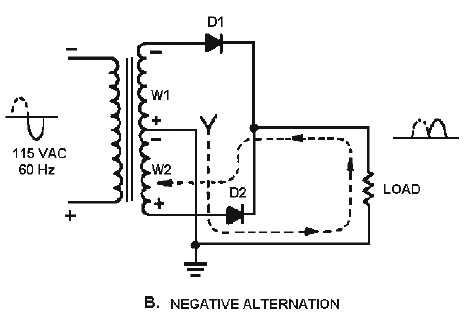4-8
Figure 4-5B.—Full-wave rectifier. NEGATIVE ALTERNATION
Now that you have a basic understanding of how a full-wave rectifier works, let's cover in detail a
practical full-wave rectifier and its waveforms.
A Practical Full-Wave Rectifier
A practical full-wave rectifier circuit is shown in view A of figure 4-6. It uses two diodes (D1 and
D2) and a center-tapped transformer (T1). When the center tap is grounded, the voltages at the opposite
ends of the secondary windings are 180 degrees out of phase with each other. Thus, when the voltage at
point A is positive with respect to ground, the voltage at point B is negative with respect to ground. Let's
examine the operation of the circuit during one complete cycle.
Figure 4-6.—Practical full-wave rectifier.
During the first half cycle (indicated by the solid arrows), the anode of D1 is positive with respect to
ground and the anode of D2 is negative. As shown, current flows from ground (center tap), up through the
load resistor (RL), through diode D1 to point A. In the transformer, current flows from point A, through



